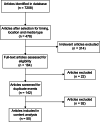Tourniquet Use in Animal Attacks: An Analysis of News Media Reports
- PMID: 33880274
- PMCID: PMC8051424
- DOI: 10.7759/cureus.13926
Tourniquet Use in Animal Attacks: An Analysis of News Media Reports
Abstract
Background Animal attacks pose a significant public health problem in the United States. Non-venomous animals are the leading cause of mortality in these attacks, and extremity injuries leading to hemorrhage are a common pattern. The Stop the Bleed campaign advocates for public training in bleeding control tactics and public access to bleeding control kits. Controlling life-threatening bleeding, as promoted by the Stop the Bleed campaign, may be a method to reduce preventable death in these attacks. Methodology We searched the Nexus Uni database, which compiles international news media articles, to collect newspaper articles in the United States between 2010 and 2019 that referenced animal attacks on humans in which a tourniquet was applied. We screened articles to assess for inclusion criteria and isolated a single report for each attack. Results A total of 50 individual attacks met the inclusion criteria and were included for data collection. Overall, 92% (n = 46) of the victims survived the attacks, and the average victim age was 33. California was the most common location of the attacks (n = 12, 24%), sharks caused the most attacks (n = 26, 52%), and victims most often sustained isolated extremity injuries (n = 24, 48% for arm and n = 24, 48% for leg). Laypeople applied the most tourniquets (n = 29, 58%), and appliers most frequently used improvised tourniquets (n = 30, 60%). Conclusions While mortality in this series was low, there are hundreds of fatalities from non-venomous animal attacks each year. Equipping and training the at-risk public to stop bleeding may save additional lives. Future Stop the Bleed efforts should improve access to public hemorrhage control equipment and expand educational outreach to people engaged in high-risk activities with animals.
Keywords: animal attacks; bystander care; hemorrhage control; preventable death; stop the bleed; tourniquet.
Copyright © 2021, Wend et al.
Conflict of interest statement
The authors have declared that no competing interests exist.
Figures
Similar articles
-
Stop the Bleed: The Effect of Hemorrhage Control Education on Laypersons' Willingness to Respond During a Traumatic Medical Emergency.Prehosp Disaster Med. 2018 Apr;33(2):127-132. doi: 10.1017/S1049023X18000055. Epub 2018 Feb 19. Prehosp Disaster Med. 2018. PMID: 29455698
-
Effectiveness of the American College of Surgeons Bleeding Control Basic Training Among Laypeople Applying Different Tourniquet Types: A Randomized Clinical Trial.JAMA Surg. 2019 Oct 1;154(10):923-929. doi: 10.1001/jamasurg.2019.2275. JAMA Surg. 2019. PMID: 31339533 Free PMC article. Clinical Trial.
-
The Tourniquet Gap: A Pilot Study of the Intuitive Placement of Three Tourniquet Types by Laypersons.J Emerg Med. 2018 Mar;54(3):307-314. doi: 10.1016/j.jemermed.2017.09.011. Epub 2017 Nov 24. J Emerg Med. 2018. PMID: 29239763 Clinical Trial.
-
Equipping Public Spaces to Facilitate Rapid Point-of-Injury Hemorrhage Control After Mass Casualty.Am J Public Health. 2019 Feb;109(2):236-241. doi: 10.2105/AJPH.2018.304773. Epub 2018 Dec 20. Am J Public Health. 2019. PMID: 30571311 Free PMC article. Review.
-
Recommendations for Improving Stop the Bleed: A Systematic Review.Mil Med. 2022 Oct 29;187(11-12):e1338-e1345. doi: 10.1093/milmed/usac019. Mil Med. 2022. PMID: 35084491
References
-
- Emergency department visits and hospitalizations associated with animal injuries, 2009: statistical brief #134. [Nov;2020 ];https://www.hcup-us.ahrq.gov/reports/statbriefs/sb134.pdf 2012 - PubMed
-
- Animal bites and stings reported by United States poison control centers, 2001-2005. Langley RL. Wilderness Environ Med. 2008;19:7–14. - PubMed
-
- An update on fatalities due to venomous and nonvenomous animals in the United States (2008-2015) Forrester JA, Weiser TG, Forrester J. Wilderness Environ Med. 2018;29:36–44. - PubMed
-
- Human fatalities caused by animal attacks: a six-year autopsy study. Tumram NK, Ambade VN, Dixit PG. Med Leg J. 2017;85:194–199. - PubMed
-
- Our story. [Oct;2020 ];https://www.stopthebleed.org/our-story 2020
Publication types
LinkOut - more resources
Full Text Sources
Other Literature Sources
Miscellaneous

